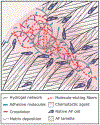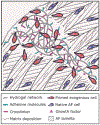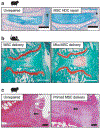Putting the Pieces in Place: Mobilizing Cellular Players to Improve Annulus Fibrosus Repair
- PMID: 32907498
- PMCID: PMC10799291
- DOI: 10.1089/ten.TEB.2020.0196
Putting the Pieces in Place: Mobilizing Cellular Players to Improve Annulus Fibrosus Repair
Abstract
The intervertebral disc (IVD) is an integral load-bearing tissue that derives its function from its composite structure and extracellular matrix composition. IVD herniations involve the failure of the annulus fibrosus (AF) and the extrusion of the nucleus pulposus beyond the disc boundary. Disc herniations can impinge the neural elements and cause debilitating pain and loss of function, posing a significant burden on individual patients and society as a whole. Patients with persistent symptoms may require surgery; however, surgical intervention fails to repair the ruptured AF and is associated with the risk for reherniation and further disc degeneration. Given the limitations of AF endogenous repair, many attempts have been made toward the development of effective repair approaches that reestablish IVD function. These methods, however, fail to recapitulate the composition and organization of the native AF, ultimately resulting in inferior tissue mechanics and function over time and high rates of reherniation. Harnessing the cellular function of cells (endogenous or exogenous) at the repair site through the provision of cell-instructive cues could enhance AF tissue regeneration and, ultimately, improve healing outcomes. In this study, we review the diverse approaches that have been developed for AF repair and emphasize the potential for mobilizing the appropriate cellular players at the site of injury to improve AF healing. Impact statement Conventional treatments for intervertebral disc herniation fail to repair the annulus fibrosus (AF), increasing the risk for recurrent herniation. The lack of repair devices in the market has spurred the development of regenerative approaches, yet most of these rely on a scarce endogenous cell population to repair large injuries, resulting in inadequate regeneration. This review identifies current and developing strategies for AF repair and highlights the potential for harnessing cellular function to improve AF regeneration. Ideal cell sources, differentiation strategies, and delivery methods are discussed to guide the design of repair systems that leverage specialized cells to achieve superior outcomes.
Keywords: annulus fibrosus; biomaterials; cell delivery; cellular function; intervertebral disc herniation; regeneration.
Conflict of interest statement
Disclosure Statement
No competing financial interests exist.
Figures





Similar articles
-
Emerging tissue engineering strategies for annulus fibrosus therapy.Acta Biomater. 2023 Sep 1;167:1-15. doi: 10.1016/j.actbio.2023.06.012. Epub 2023 Jun 16. Acta Biomater. 2023. PMID: 37330029 Review.
-
Mechanically tough, adhesive, self-healing hydrogel promotes annulus fibrosus repair via autologous cell recruitment and microenvironment regulation.Acta Biomater. 2024 Apr 1;178:50-67. doi: 10.1016/j.actbio.2024.02.020. Epub 2024 Feb 19. Acta Biomater. 2024. PMID: 38382832
-
Repair and Regenerative Therapies of the Annulus Fibrosus of the Intervertebral Disc.J Coll Physicians Surg Pak. 2016 Feb;26(2):138-44. J Coll Physicians Surg Pak. 2016. PMID: 26876403 Review.
-
Advanced Strategies for the Regeneration of Lumbar Disc Annulus Fibrosus.Int J Mol Sci. 2020 Jul 10;21(14):4889. doi: 10.3390/ijms21144889. Int J Mol Sci. 2020. PMID: 32664453 Free PMC article. Review.
-
A novel rat model of annulus fibrosus injury for intervertebral disc degeneration.Spine J. 2024 Feb;24(2):373-386. doi: 10.1016/j.spinee.2023.09.012. Epub 2023 Oct 3. Spine J. 2024. PMID: 37797841
Cited by
-
Role of neurogenic inflammation in intervertebral disc degeneration.World J Orthop. 2025 Jan 18;16(1):102120. doi: 10.5312/wjo.v16.i1.102120. eCollection 2025 Jan 18. World J Orthop. 2025. PMID: 39850033 Free PMC article. Review.
-
Crosslinking stabilization strategy: A novel approach to cartilage-like repair of annulus fibrosus (AF) defects.Mater Today Bio. 2025 Mar 5;31:101625. doi: 10.1016/j.mtbio.2025.101625. eCollection 2025 Apr. Mater Today Bio. 2025. PMID: 40124345 Free PMC article.
-
Therapeutic factors and biomaterial-based delivery tools for degenerative intervertebral disc repair.Front Cell Dev Biol. 2024 Feb 5;12:1286222. doi: 10.3389/fcell.2024.1286222. eCollection 2024. Front Cell Dev Biol. 2024. PMID: 38374895 Free PMC article. Review.
-
Developmental morphogens direct human induced pluripotent stem cells toward an annulus fibrosus-like cell phenotype.JOR Spine. 2024 Jan 25;7(1):e1313. doi: 10.1002/jsp2.1313. eCollection 2024 Mar. JOR Spine. 2024. PMID: 38283179 Free PMC article.
-
Barriers to mesenchymal stromal cells for low back pain.World J Stem Cells. 2022 Dec 26;14(12):815-821. doi: 10.4252/wjsc.v14.i12.815. World J Stem Cells. 2022. PMID: 36619693 Free PMC article.
References
-
- Cassidy JJ, Hiltner A, and Baer E Hierarchical structure of the intervertebral disc. Connect Tissue Res 23, 75, 1989. - PubMed
-
- Raj PP Intervertebral disc: anatomy-physiology-pathophysiology-treatment. Pain Pract 8, 18, 2008. - PubMed
-
- Roberts S Disc morphology in health and disease. Biochem Soc Trans 30, 864, 2002. - PubMed
-
- Roberts S Histology and pathology of the human intervertebral disc. J Bone Joint Surg Am 88, 10, 2006. - PubMed
-
- Humzah MD, and Soames RW Human intervertebral disc: structure and function. Anat Rec 220, 337–356, 1988. - PubMed
Publication types
MeSH terms
Grants and funding
LinkOut - more resources
Full Text Sources
Medical

